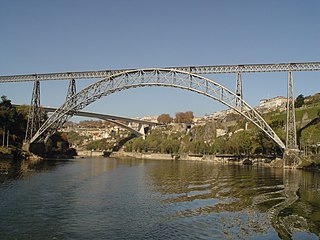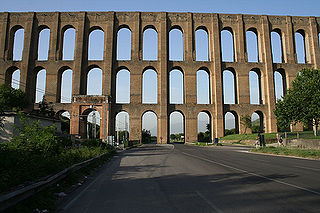
Lisbon is the capital and the largest city of Portugal, with an estimated population of 505,526 within its administrative limits in an area of 100.05 km2. Lisbon's urban area extends beyond the city's administrative limits with a population of around 2.8 million people, being the 10th-most populous urban area in the European Union. About 3 million people live in the Lisbon metropolitan area, which represents approximately 27% of the country's population. It is mainland Europe's westernmost capital city and the only one along the Atlantic coast. Lisbon lies in the western Iberian Peninsula on the Atlantic Ocean and the River Tagus. The westernmost portions of its metro area, the Portuguese Riviera, form the westernmost point of Continental Europe, culminating at Cabo da Roca.

The Tagus is the longest river in the Iberian Peninsula. It is 1,007 km (626 mi) long, 716 km (445 mi) in Spain, 47 km (29 mi) along the border between Portugal and Spain and 275 km (171 mi) in Portugal, where it empties into the Atlantic Ocean near Lisbon. It drains an area of 80,100 square kilometers (30,927 sq mi). The Tagus is highly utilized for most of its course. Several dams and diversions supply drinking water to places of central Spain and Portugal, while dozens of hydroelectric stations create power. Between dams it follows a very constricted course, but after Almourol it enters a wide alluvial valley, prone to flooding. Its mouth is a large estuary near the port city of Lisbon.

Oporto, also known as Porto, is the second-largest city in Portugal, one of the Iberian Peninsula's major urban areas. Oporto city has a population of 237,559 and a metropolitan area with 2.4 million people (2019) in an area of 2,395 km2 (925 sq mi), making it the second-largest urban area in Portugal. It is recognized as a gamma-level global city by the Globalization and World Cities (GaWC) Study Group, the only Portuguese city besides Lisbon to be recognised as a global city.

The Carnation Revolution, also known as the 25 April, was initially a 25 April 1974 military coup in Lisbon which overthrew the authoritarian Estado Novo regime. The revolution began as a coup organised by the Armed Forces Movement, composed of military officers who opposed the regime, but it was soon coupled with an unanticipated, popular civil resistance campaign. The revolution led to the fall of the Estado Novo, terminated the Portuguese Colonial War, and started a revolutionary process that would result in a democratic Portugal.

Chaves is a city and a municipality in the north of Portugal. It is 10 km south of the Spanish border and 22 km south of Verín (Spain). The population in 2011 was 41,243, in an area of 591.23 km2. The municipality is the second most populous of the district of Vila Real. With origins in the Roman civitas Aquæ Flaviæ, Chaves has developed into a regional center. The urban area has 17,535 residents (2001).

Trajan's Bridge is a Roman bridge in the civil parish of Santa Maria Maior, in the municipality of Chaves in the Portuguese northern subregion of Terras de Trás-os-Montes.

Olivenza or Olivença is a town situated on a disputed section of the Portugal–Spain border. Its territory is administered by Spain as a municipality belonging to the province of Badajoz, and to the wider autonomous community of Extremadura. Portugal does not recognise the Spanish sovereignty over the territory, based on its interpretation of the rulings of the 1815 Congress of Vienna. Spain accepted the Treaty on 7 May 1817; however, Olivença and its surroundings were never returned to Portuguese control and this question remains unresolved and Portugal holds a claim over it.

Tete is the capital city of Tete Province in Mozambique. It is located on the Zambezi River, and is the site of two of the four bridges crossing the river in Mozambique. A Swahili trade center before the Portuguese colonial era, Tete continues to dominate the west-central part of the country and region, and is the largest city on the Zambezi. In the local language, Nyungwe, Tete means "reed."

Alcántara is a municipality in the province of Cáceres, Extremadura, Spain, on the Tagus, near Portugal. The toponym is from the Arabic word al-Qanṭarah (القنطرة) meaning "the bridge".

The Vasco da Gama Bridge is a cable-stayed bridge flanked by viaducts and rangeviews that spans the Tagus River in Parque das Nações in Lisbon, the capital of Portugal.

The 25 de Abril Bridge is a suspension bridge connecting the city of Lisbon, capital of Portugal, to the municipality of Almada on the left (south) bank of the Tagus river. It was inaugurated on August 6, 1966. It is often compared to the Golden Gate Bridge in San Francisco, US, because they are both suspension bridges of similar color. It was built by the American Bridge Company which constructed the San Francisco–Oakland Bay Bridge, but not the Golden Gate. With a total length of 2,277 metres (7,470 ft), it is the 40th largest suspension bridge in the world. The upper deck carries six car lanes, while the lower deck carries a double track railway electrified at 25 kV AC; the train platform was added in 1999. From 1966–1974, the bridge was named Salazar Bridge in honor of Portuguese Prime Minister António de Oliveira Salazar, who ordered its construction. After the Carnation Revolution which overthrew the remnants of Salazar's dictatorship, the bridge was renamed for April 25, the date of the revolution. It is also sometimes called the Tagus River Bridge or in Portuguese Ponte sobre o Tejo.

The Arrábida Bridge is an arch bridge of reinforced concrete which carries six lanes of traffic over the Douro River, between Porto and Vila Nova de Gaia, in the Norte region of Portugal.

The Combat of the Côa was a skirmish that occurred during the Peninsular War period of the Napoleonic Wars. It took place in the valley of the Côa River and it was the first significant battle for the new army of 65,000 men controlled by Marshal André Masséna, as the French prepared for their third invasion of Portugal.

The Maria Pia Bridge is a railway bridge built in 1877, and attributed to Gustave Eiffel, situated over the Portuguese northern municipalities of Porto and Vila Nova de Gaia.

The Dom Luís I Bridge, or Luís I Bridge, is a double-deck metal arch bridge that spans the River Douro between the cities of Porto and Vila Nova de Gaia in Portugal. At its construction, its 172 metres (564 ft) span was the longest of its type in the world. It has been confused with the nearby Maria Pia Bridge, a railway bridge that was built 9 years earlier, which is similar in aspect to the Luís I bridge.

The Battle of Almaraz was a battle of the Peninsular War which took place on 18/19 May 1812, in which the Anglo-Portuguese Army under Lord Hill destroyed a French pontoon bridge across the River Tagus, in Almaraz, Spain. The bridge was protected by two French garrisons at either end.

The Bridge of Cava da Velha is a Roman bridge, situated in the civil parish of Castro Laboreiro e Lamas de Mouro, in the municipality of Melgaço in northern Portuguese district of Viana do Castelo.

The Porto Half Marathon is an annual half marathon road running event held in Porto, Portugal which follows the River Douro. Known as the Hyundai Porto Half Marathon for sponsorship reasons, the inaugural edition was held in 2007 and it typically takes place every mid-September.

Aqueducts or water bridges are bridges for conveying water. They are constructed to convey watercourses across gaps such as valleys or ravines. The term aqueduct may also be used to refer to the entire watercourse, as well as the bridge. Large navigable aqueducts are used as transport links for boats or ships. Aqueducts must span a crossing at the same level as the watercourses on each end. The word is derived from the Latin aqua ("water") and ducere. Therefore meaning "to lead water". A modern version of an aqueduct is a pipeline bridge. They may take the form of tunnels, networks of surface channels and canals, covered clay pipes or monumental bridges.
The Brazilian Bridge Federation is the national organization for bridge in Brazil and a member of the Confederacion Sudamericana de Bridge and the World Bridge Federation. It was founded in 1945 as the Confederação Brasileira de Bridge, affiliated with the World Bridge Federation in 1979, and fully recognized by it in June 1999.




















